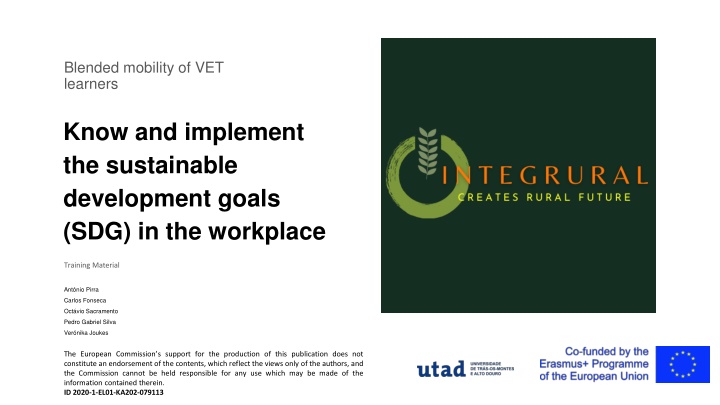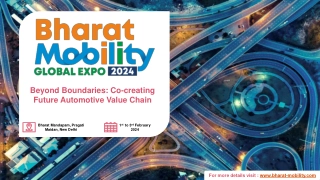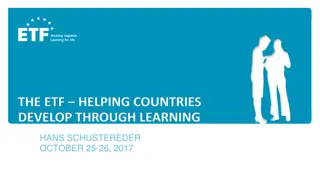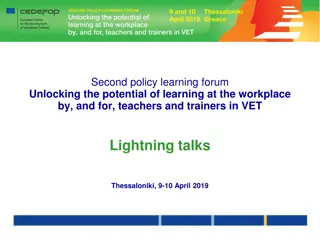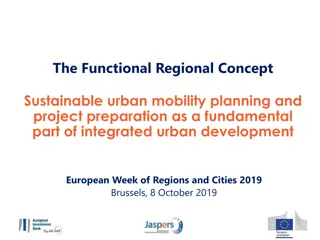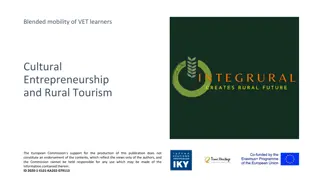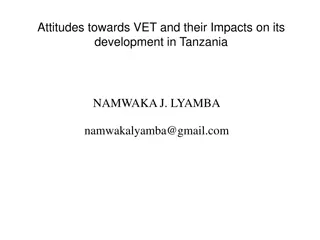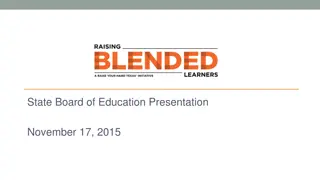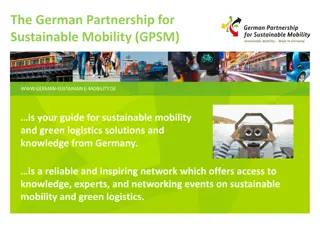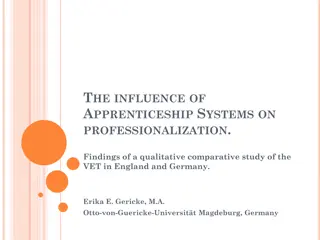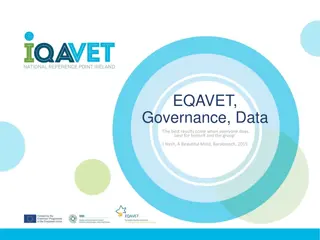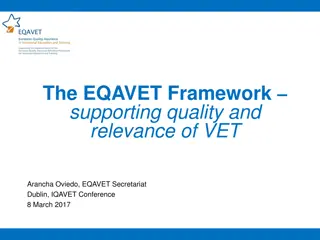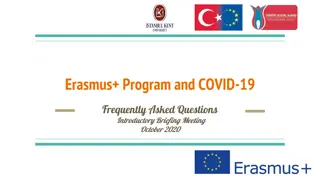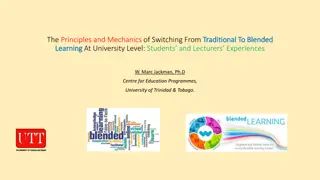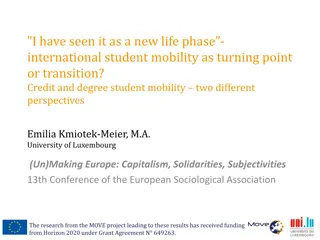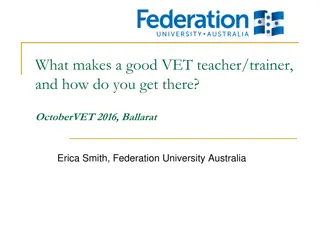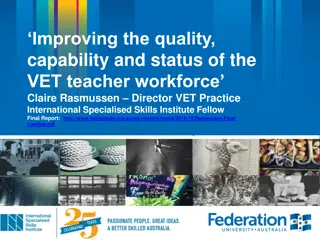Blended Mobility of VET Learners: Implementing Sustainable Development Goals in the Workplace
This training material provides skills and tips for implementing the Sustainable Development Goals (SDGs) and global thinking in work environments. It covers sustainability pillars, SDGs mapping, EU progress in SDGs, rural development policy, challenges in SDG implementation, case studies, and more.
Uploaded on Mar 14, 2025 | 1 Views
Download Presentation

Please find below an Image/Link to download the presentation.
The content on the website is provided AS IS for your information and personal use only. It may not be sold, licensed, or shared on other websites without obtaining consent from the author.If you encounter any issues during the download, it is possible that the publisher has removed the file from their server.
You are allowed to download the files provided on this website for personal or commercial use, subject to the condition that they are used lawfully. All files are the property of their respective owners.
The content on the website is provided AS IS for your information and personal use only. It may not be sold, licensed, or shared on other websites without obtaining consent from the author.
E N D
Presentation Transcript
Blended mobility of VET learners Know and implement the sustainable development goals (SDG) in the workplace Training Material Ant nio Pirra Carlos Fonseca Oct vio Sacramento Pedro Gabriel Silva Ver nika Joukes The European Commission s support for the production of this publication does not constitute an endorsement of the contents, which reflect the views only of the authors, and the Commission cannot be held responsible for any use which may be made of the information contained therein. ID 2020-1-EL01-KA202-079113
INTRODUCTION INTRODUCTION This material is oriented to those that want to have some basic, general skills, advices and tips to implement the Sustainable Development Goals (SDGs) and global thinking in their work environment.
CONTENTS CONTENTS 1. Sustainability definition 2. The sustainability pillars 3. Elements of sustainability 4. Mapping and characterization of the 17 SDGs 5. Progress in the implementation of the SDGs in the EU 6. EU rural development policy and SDGs 7. Implementation of SDG - Food and Agriculture Business Principles 8. SDGs implementation by micro entrepreneurs and innovators in rural contexts a broader look 9. SDGs implementation by micro entrepreneurs and innovators in rural contexts a closer look
CONTENTS (cont.) CONTENTS (cont.) 10. SDGs implementation by micro entrepreneurs and innovators in rural contexts challenges; 11. Implementation of SDG by the states, communities and companies case studies and good practices 12. Implementation of SDG by the states, communities and companies sites 13. Enter into action mode: things to reflect on/to do 14. Some examples of already well known everyday life basic sustainability actions
1. Sustainability definition 1. Sustainability definition The origins of the sustainability concept lay in the Brundtland report, where the United Nation s World Commission on Environment and Development (WCED) defined sustainable development in 1987 as development capable to ensure that it meets the needs of the present without compromising the ability of future generations to meet their own needs (WCED, 1987, p. 16). If you want to live according to this precept, you have to work on three levels simultaneously: the economic, environmental and social pillars of sustainability. Meanwhile the United Nations ameliorated and transformed this definition formulating the sustainable development goals (SDG). Until 2030 the whole world should join forces to realize them in order to secure the survival of the planet, guarantying well-being for all. In other words, they address the global challenges we face, including those related to poverty, inequality, climate change, environmental degradation, peace and justice (United Nations, 2015).
2. The sustainability pillars 2. The sustainability pillars Economy Environmental Social https://careers.snclavalin.com/blogs/2022-3/three-pillars-of-sustainability-and-the-built-environment
3. Elements of sustainability 3. Elements of sustainability Economy: Economy: money and capital; employment; technological growth; investment; market forces Environment: Environment: biodiversity; materials; energy; biophysical interactions Social: Social: human diversity, (cultural, linguistic, ethnic) equity; quality of life; institutional structures; organizational/political structures
4 4. . Mapping Mapping and and characterization characterization of of the the 17 17 SDGs SDGs The United Nations promote the realisation of the sustainable development goals (SDG) until 2030 as a way to secure the survival of the planet, guarantying well-being for all. It concerns 17 goals, 169 targets and 230 global indicators. The latter being a robust framework intended for follow-up and review of progress at the global level towards achieving the 17 SDGs . Thanks to social media the SDG are becoming ever more present in our daily lives. One example being that most of us are meanwhile familiarized with this colourful visual:
5. Progress in the implementation of the SDGs in the EU 5. Progress in the implementation of the SDGs in the EU https://ec.europa.eu/eurostat/web/sdi/key-findings
5. Progress in the implementation of the SDGs in the EU 5. Progress in the implementation of the SDGs in the EU (cont.) (cont.) Strong progress * Good progress Moderate progress: No progress # SDG 16 Peace and Justice SDG 1 - Reducing poverty and social exclusion SDG 8 Decent work and economic growth SDG7 - Clean and affordable energy SDG9 - Innovation and infrastructure SDG 3 - Well-being SDG 14 - Life below water SDG 5) - Gender equality SDG 11 - Sustainable cities and communities SDG 10 - Reduced inequalities SDG 12 - Responsible consumption and production SDG 4 - Quality education; SDG 13 - Climate action SDG 12 - Zero hunger SDG 17 - Partnerships for the goals SDG 6 - Clean water and sanitation SDG 15 -Life on land * poverty data do not consider the full impact of the COVID * poverty data do not consider the full impact of the COVID- -19; clean energy is positively influenced by a significant reduction 19; clean energy is positively influenced by a significant reduction in energy consumption because of COVID consumption because of COVID- -19; 19; # have nearly equal numbers of sustainable and unsustainable developments # have nearly equal numbers of sustainable and unsustainable developments https://ec.europa.eu/eurostat/web/sdi/key-findings in energy
6. EU rural development policy and SDGs 6. EU rural development policy and SDGs EU agricultural and rural development policies contribute mainly to the following SDGs: SDG 2 Zero hunger SDG 1 No poverty SDG 8 Decent work and economic growth SDG 12 Responsible consumption and production SDG 15 Life on land https://agriculture.ec.europa.eu/international/international-cooperation/international-organisations/un-sustainable- development-goals_en
7. Implementation of SDG 7. Implementation of SDG - - food and agriculture business food and agriculture business principles principles 1. Aim for Food Security, Health and Nutrition: Businesses should support food and agriculture systems that optimize production and minimize waste, to provide nutrition and promote health for all people ; 2. Be Environmentally Responsible: Businesses should support sustainable intensification of food systems to meet global needs by managing agriculture, livestock, fisheries and forestry responsibly. They should protect and enhance the environment ; 3. Ensure Economic Viability and Share Value: Businesses should create, deliver and share value across the entire food and agriculture chain from farmers to consumers ; https://unglobalcompact.org/take-action/action/food
7. Implementation of SDG 7. Implementation of SDG - - food and agriculture business food and agriculture business (cont.) (cont.) 4. Respect Human Rights, Create Decent Work and Help Communities To Thrive Businesses should respect the rights of farmers, workers and consumers. They should improve livelihoods, promote and provide equal opportunities ; 5. Encourage Good Governance and Accountability Businesses should behave legally and responsibly by respecting land and natural resource rights, avoiding corruption, being transparent about activities and recognizingtheir impacts ; 6. Promote Access and Transfer of Knowledge, Skills and Technology Businesses should promote access to information, knowledge and skills for more sustainable food and agricultural systems . https://unglobalcompact.org/take-action/action/food
8. SDGs implementation by micro entrepreneurs and 8. SDGs implementation by micro entrepreneurs and innovators in rural contexts innovators in rural contexts a broader look a broader look Since 2015, the 17 SDGs were meant to be a global response to the challenges of climate change, ecological degradation, socioeconomic inequality and sustainable development. Micro Microentrepreneurs entrepreneurs(& (& innovators) innovators)in in rural ruralareas areasplay playa a key keyrole rolein in achieving achievingSDGs SDGs Why? Why? Placed in rural contexts, they can better identify local needs and opportunities; due to their placement, they have a deep knowledge of local ecological systems and are more likely to promote more sustainable land uses (Ogutu et al 2020) How? How? By being creative, resourceful and skilful in developing sustainable products and services Benefiting Benefiting: : their own economic condition and well-being, the community, and the environment
9. SDGs implementation by micro entrepreneurs and 9. SDGs implementation by micro entrepreneurs and innovators in rural contexts innovators in rural contexts a closer look a closer look Micro rural entrepreneurs contribute to: - sustainable food systems by using agro-ecological methods such as permaculture and agroforestry, which help to reduce the environmental impacts of agricultural practices, addressing, in a combined manner, at least SDGs 1, 2, 11, 12 (Genuset al 2021); - sustainable solutions to access clean water, sanitation, and healthcare, like the case of Malawi s development of solar water pumps small framer (Kelly, 2023) or in India, where micro entrepreneurs are developing innovative solutions to provide clean energy in rural areas based on solar-powered irrigation pumps and low-cost mini-grid systems. These solutions help to reduce poverty, contributing to the SDG of affordableand clean energy (Lal et al., 2019); - reduce poverty by creating jobs and providing access to basic goods and services. The International Labour Organization (ILO) found that 30% of small entrepreneurs in rural India were actively contributing to reduce poverty (ILO, 2019); - improve access to healthcare. In Ethiopia, innovative solutions include mobile health clinics, mobile telemedicine, and m-health apps (Ayalew et al., 2019), contributing to reduce poverty and improve healthcare access, (alsocontributing to the SDG of Good Healthand Wellbeing).
10. SDGs implementation by micro entrepreneurs and 10. SDGs implementation by micro entrepreneurs and innovators in rural contexts innovators in rural contexts challenges challenges Although micro rural entrepreneurs contribute to counter the obstacles SGSs implementation faces in rural areas, they still have to overcome a series of challenges (Kandpal et al., 2018; Nyamu-Musembi & Campbell, 2018): - access to resources and capital; - limited access to markets and capacity to scale up; - lack of infrastructure and technology; - limited access to education and training.
11. Implementation of SDG by the states, communities 11. Implementation of SDG by the states, communities and companies and companies case studies and good practices case studies and good practices 17 Companies Helping Meet the 17 UN Sustainable Development Goals 17 Companies Helping Meet the 17 UN Sustainable Development Goals https://fi.co/insight/17-companies-helping-meet-the-17-un-sustainable-development-goals Case Studies Case Studies Achieving SDG Achieving SDG https://www.sdgfund.org/case-studies EU EU - - International partnerships International partnerships https://international-partnerships.ec.europa.eu/news-and-events/stories_en SDG Good Practices SDG Good Practices - - A compilation of success stories and lessons learned in SDG implementation A compilation of success stories and lessons learned in SDG implementation https://sdgs.un.org/publications/sdg-good-practices-2020 SDG Good Practices SDG Good Practices - - A compilation of success stories and lessons learned in SDG implementation A compilation of success stories and lessons learned in SDG implementation https://sdgs.un.org/publications/sdg-good-practices-2nd-edition-2022
12. Implementation of SDG by states, communities and 12. Implementation of SDG by states, communities and companies companies sites sites Eurostat Eurostat https://ec.europa.eu/eurostat/web/sdi World Business Council for Sustainable Development (WBCSD) World Business Council for Sustainable Development (WBCSD) https://www.wbcsd.org/Programs/People-and-Society/Sustainable-Development-Goals United Nations Development Programme (UNDP) United Nations Development Programme (UNDP) - - SDG accelerator SDG accelerator https://www.undp.org/sdg-accelerator UNDP UNDP - - SDG Integration SDG Integration https://sdgintegration.undp.org/ EU KnowSDGs Platform EU KnowSDGs Platform https://knowsdgs.jrc.ec.europa.eu/ UN Global Compact UN Global Compact https://unglobalcompact.org/sdgs/17-global-goals European Commission European Commission - - SDG SDG https://commission.europa.eu/strategy-and-policy/international-strategies/sustainable-development-goals_en
13. Enter into action mode: things to reflect on/to do 13. Enter into action mode: things to reflect on/to do - Pay a visit to the site through which the UN wants to help governments and stakeholders to make the SDGs a reality: https://sustainabledevelopment.un.org/; - Knowing the SDG will help you to become an even more responsible entrepreneur, you can deepen your knowledge about them by reading and/or by enrolling in a specialized program, be it during a face-to-face or an online training; - Recognise and analyse how the SDGs are being implemented; - Analyse existing communication strategies (of the SDGs) by other companies; - Assess what you are doing in your workplace to improve sustainable development; - Decide which of the SDGs you want to improve or implement in your workplace; - Select good practices that can be implemented and consciously associated with the SDGs; - Define a timeline for the implementation of the new SDG and/or components; - Define a basic communication strategy about what your company/organization does in favour of the SDGs;
13. Enter into action mode: things to reflect on/to do (cont.) 13. Enter into action mode: things to reflect on/to do (cont.) - Don t wait to create your own network with other professionals and volunteers who also decided to actively engage with the SDG. You need to share with the outside world what you do in favour of the SDG regularly, as today s clients are very sensitive to this kind of concerns; - You can insert the logos of the goals that you work on in your promotional material or you can invest in content marketing informing your clients in detail about some specific targets (Joukes & Pirra, 2020); - Here are some websites where you can find information about the SDG and how to implement them in you company: https://sdgcompass.org/ https://www.unglobalcompact.org/sdgs/about https://sdghub.com/ https://www.businesscalltoaction.org/ https://www.sdgfund.org/business-and-un - One tip for further reading: article that introduces you into What Is Corporate Social Responsibility? : https://www.businessnewsdaily.com/4679-corporate-social-responsibility.html
14. Some examples of already well known basic 14. Some examples of already well known basic everyday life sustainability actions everyday life sustainability actions - Reduce, recycle, reuse (water, energy, plastics, packaging, ); - Conscious exploitation of natural resources; - Prefer local products and services; - Preservation of natural assets combined with social dignity; - Decrease the rate of consumption; - Launch socio-environmental population awareness programs; - Invest in renewable sources of energy; - Reforest.
References References Ayalew, H., Zewudie, T., & Binesh, N. (2019). The Role of m Health in Achieving the Sustainable Development Goals in Ethiopia. InternationalJournalof EnvironmentalResearchandPublicHealth,16(16), 2924. Genus, A, Iskandarova, M, Warburton Brown, C. Institutional entrepreneurship and permaculture: A practice theory perspective.BusStratEnv.2021; 30: 1454 1467. https://doi.org/10.1002/bse.2708 Kandpal, E., Yarlagadda, P., Pradhan, B., & Jha, R. (2018). Challenges to Implementing the Sustainable Development Goals in Rural Areas: A Review. International Journal of Environmental https://doi.org/10.3390/ijerph15081611 Kelly, E. (2023), How a solar-powered water pump has transformed farming in a Malawi village, Concern Worldwide, 20 January2023, https://www.concern.net/news/how-solar-powered-water-pump-has-transformed-farming-malawi-village Lal, R., Srivastava, M., Pitroda, S., & Shah, N. (2019). Access to clean energy in rural India: Role of small entrepreneurs. RenewableandSustainableEnergyReviews,102, 202 213. Nyamu-Musembi, C., & Campbell, B. (2018). Implementing the Sustainable Development Goals in rural areas: A review. International Journal of Sustainable Development https://doi.org/10.1080/13504509.2018.1436005 Ogutu, S.O., G decke, T. and Qaim, M. (2020), Agricultural Commercialisation and Nutrition in Smallholder Farm Households. J AgricEcon, 71: 534-555. https://doi.org/10.1111/1477-9552.12359 United Nations (2015). Transforming our world: The 2030 Agenda for Sustainable Development.United Nations General Assembly; Seventieth Session, New York, September18. World Commission on Environment and Development - WCED (1987). Our common future. Oxford University Press. Research and Public Health, 15(8), 1611. & World Ecology, 25(3), 259-269.
